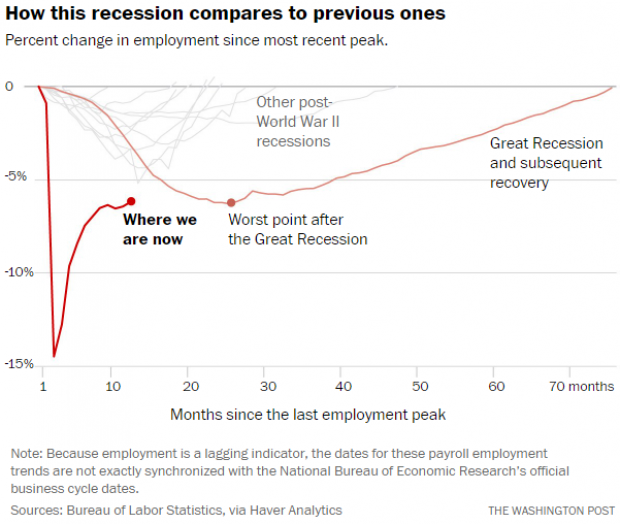The U.S. labor market added 379,000 jobs in February, the Labor Department announced Friday, raising hopes that the economy is accelerating as it heads into the spring.
The pace of hiring was faster than expected, with most of the job growth concentrated in the virus-ravaged leisure and hospitality sectors. The jobs numbers for January were also revised higher, bringing the new jobs total for the first two months of the year to 545,000.
The topline number was weighed down by bad weather throughout much of the country, which typically limits hiring, especially in industries that involve outdoor work such as construction. Employment in state and local public education also fell during the month, with a loss of 69,000 jobs.
The unemployment rate ticked slightly lower to 6.2%, though pronounced differences in the population persisted. The jobless rate fell to 5.6% for white workers and 8.5% for Hispanic workers, while it rose to 9.9% for Black workers.
“What we’re seeing is broad, slow gains,” Julia Pollak of the job site ZipRecruiter told The New York Times. “It’s consistent with a slow reawakening of the labor market after a winter hibernation.”
JP Morgan’s Michael Feroli said in a note that the report hints at better times to come in the labor market. “Overall this was a pretty good report, and we expect even better numbers in coming months as the incredibly powerful tailwind of reopening should support some rather large job growth figures.”
Too soon to celebrate: Though the jobs report provided better-than-expected results, the U.S. economy still has a long way to go before it returns to pre-pandemic conditions – and the latest report may not be quite as good as it appears. Joseph Brusuelas, chief economist at the consulting firm RSM, wrote Friday that “the major policy takeaway from this report is that there has not been a dramatic acceleration in hiring.” Most of the new jobs simply made up for layoffs in the late fall and early winter, Brusuelas said, and job losses were recorded in the goods-producing and financial sectors, with little growth outside low-wage areas marked by temporary employment.
With the real unemployment rate hovering near 10%, Brusuelas said there was little in the jobs report to suggest that economic conditions have fundamentally changed. “The report will neither persuade the Federal Reserve to alter its path of accommodative monetary policy, nor should it be used as an argument to pull back on the Biden administration’s proposal for $1.9 trillion in fiscal stimulus,” he wrote.
Goldman Sachs chief economist Jan Hatzius said Friday that while the jobs report is better than could have been expected just a few months ago, the risk of permanent damage to the U.S. economy remains. “I think that’s why expansionary monetary and fiscal policy is the right call here because you want to minimize the time it takes before you get to something more normal,” he told CNBC.
Politics of Covid relief: The White House embraced the February report in its effort to push Democrat’s $1.9 trillion Covid spending package Friday.
"Today's jobs report shows that the American Rescue plan is urgently needed,” President Joe Biden said, noting that there are still 9.5 million fewer jobs than there were at the start of the pandemic. “At that rate it would take two years to get us back on track.”
White House Chief of Staff Ron Klain provided a little more detail for the argument. “If you think today's jobs report is ‘good enough,’ then know that at this pace (+379,000 jobs/month), it would take until April 2023 to get back to where we were in February 2020, Klain tweeted.




